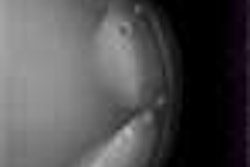VIENNA - The premise makes sense. We know that cardiovascular disease is the leading cause of death among women in the western world. And we know that women at highest risk for cardiovascular disease -- those over 50 -- are far more likely to undergo screening mammography than evaluation for asymptomatic cardiovascular disease.
So if the presence of breast artery calcium could be correlated to the risk of cardiovascular disease, could we use breast artery calcium (BAC) visible on routine screening mammography as a screening tool to gauge the risk of cardiovascular disease (CVD) in women at high risk?
Dr. Pavel Crystal from the Soroku University Medical Center at Ben Gurion University, Beer Sheva, Israel, thinks so. At today's technical breast sessions of the European Congress of Radiology, Crystal discussed the results of a survey that analyzed the presence of BAC and CVD in 927 women, mean age 67 (+/- 10 years), who had undergone screening mammography.
The women were divided into three groups by age, including Group 1, ages 55 and younger; Group 2, ages 56-65; and Group 3, ages 65 and older. They were asked to fill out a questionnaire about the presence of atherosclerotic vascular disease, as well as the presence of major cardiovascular risk factors such as hypertension and family history of cardiovascular disorders.
Their mammograms were reviewed independently by two mammographers for the presence of BAC. According to the results, 17% of the women were BAC-positive, and the incidence of BAC increased with age, Crystal said. Only 3.6% of women in Group 1 had BAC, compared with 19.5% in Group 2, and 43% in Group C.
The percentage of women with CVD followed an age-based curve. In Group 1, 5.7% had CVD; in Group 2 the frequency rose to 11.8%; and in Group 3, 25.5% had clinical CVD.
"We did a multiple logistical inversion analysis to evaluate the input of various risk factors to the presence of cardiovascular disorders," Crystal said. "And we found that breast calcification was an independent risk factor for the presence of cardiovascular disorders in all the age groups."
The other risk factors included family history of cardiovascular disease, hypertension, diabetes, menopause, dyslipidemia, and smoking, which was an important risk factor among younger women. Family history was a significant factor for the presence of cardiovascular disease in all age groups.
In addition, the positive predictive value of BAC was higher in older patients, while the negative predictive value of BAC decreased with age. The sensitivity of BAC to CVD was higher in older patients, he said.
"We think that mammography is not an effective tool for screening existing cardiovascular disease, but mammography may be an inexpensive tool for the detection of cardiovascular risk factors in women, especially in the age group older than 55 years," Crystal said. "We need a large prospective study for the evaluation of mammography, not only as a tool for screening breast cancer, but also for cardiovascular disease."
By Eric BarnesAuntminnie.com staff writer
March 3, 2001
Click here to post your comments about this story. Please include the headline of the article in your message.
Copyright © 2001 AuntMinnie.com



















